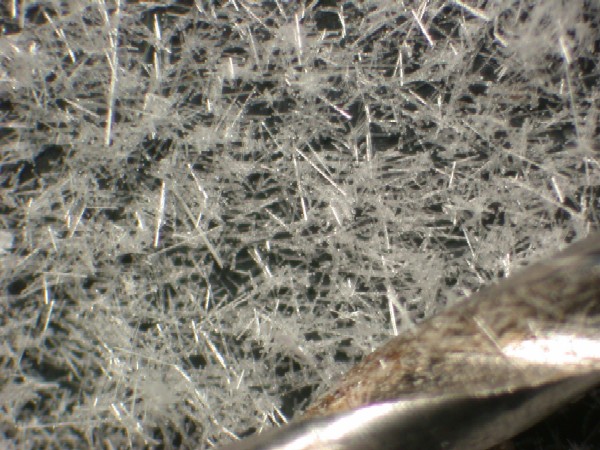Does anyone here know anything about Greg Smallman's epoxy and milled carbon fiber fingerboards?
A friend of mine who was at one of his lectures a few years ago told me that he mixes epoxy with milled carbon fiber (similar to dust), and pores it into a mold that has nylon strings at the fret locations. This is then heated to 50C and put into some type of vacuum to remove air bubbles. From what I've heard Greg showed slides of this at the Dundee Guitar Festival several years ago. Are there any photos of this or dvd's? I've email Greg about this but he never responds to any of my emails. The only time he emailed me over the past few years was last week when he found out I had a copy of his 2009 Playmakers lecture and wanted to know how I got it.
Smallman Carbon Fiber Epoxy Fingerboards?
-
schrammguitars
- Sassafras
- Posts: 48
- Joined: Fri Nov 06, 2009 3:03 am
- Location: Clovis, California USA
- Contact:
Smallman Carbon Fiber Epoxy Fingerboards?
David Schramm
www.schrammguitars.com
www.schrammguitars.com
-
Rick Turner
- Blackwood
- Posts: 310
- Joined: Sun Jan 13, 2008 10:22 am
- Location: Santa Cruz, Ca.
- Contact:
David...nice to see you over here!
I don't know about that, but it seems kind of inefficient as a way to make a fingerboard. I'd think that to really take advantage of the compression strength, you'd want a real layup.
I patented a carbon fiber fingerboard with stiffening webs back in 1989 when I worked for Gibson. We only made a few, but they were incredible. One guitar was an SG for Robbie Krieger. Carbon fiber fingerboard, flame maple top. Fantastic sounding guitar.
BTW, there is a carbon nano tube powder that can be added to the epoxy used in CF layups that significantly increases the compression strength of the material by taking up a lot of the room otherwise occupied by resin. I'll dig for the info. Just don't breathe the stuff...
I don't know about that, but it seems kind of inefficient as a way to make a fingerboard. I'd think that to really take advantage of the compression strength, you'd want a real layup.
I patented a carbon fiber fingerboard with stiffening webs back in 1989 when I worked for Gibson. We only made a few, but they were incredible. One guitar was an SG for Robbie Krieger. Carbon fiber fingerboard, flame maple top. Fantastic sounding guitar.
BTW, there is a carbon nano tube powder that can be added to the epoxy used in CF layups that significantly increases the compression strength of the material by taking up a lot of the room otherwise occupied by resin. I'll dig for the info. Just don't breathe the stuff...
Rick Turner
Guitar Maker, Experimenter, Diviner
www.renaissanceguitars.com
www.d-tar.com
Guitar Maker, Experimenter, Diviner
www.renaissanceguitars.com
www.d-tar.com
 The following was being typed as Rick posted
The following was being typed as Rick posted Welcome David.
I'm not familiar with Smallman BUT I am familiar with the principles of the technique you described when using poly/vinylesters and glass fibres.
Until recently I worked in a small liquid composite/resin research company, the financial situation meant that I'm currently (hopefully temporarily) unemployed, anyways..........He is using a liquid composite (microfibre/resin mix). I suspect that the air is introduced to the resin when the fibres are being mixed in, it is likely that a lot of the micro bubbles have attached themselves to the fibres and subjecting the "mix" to vacuum is the only way to evacuate the air. Again I suspect, that heat is applied to accelerate the gel time of the epoxy.......left "ungelled" for too long and the fibres will to settle out. Fibre size (length and diameter), fibre to resin ratio, quantity of residual fibre dust and specific resin type are all critical in achieving a satisfactory product.
I'm currently carrying out machining trials for my scientist (ex)boss and as there were only the two of us I still have full access to our facility. If my boss wasn't flat out getting ready to head to the US in a couple of days, I would try to get more detailed information.
If it worked the pic is of glass fibres with a 1mm drill bit
Chris
Music creates a kind of pleasure which human nature cannot do without.
-
schrammguitars
- Sassafras
- Posts: 48
- Joined: Fri Nov 06, 2009 3:03 am
- Location: Clovis, California USA
- Contact:
Hi Rick and Chris. Thanks for the replies. Interesting stuff. From the samples that I made the fingerboards were not all that stiff. They were very light and hard. I don't see how Smallman's could have been much stiffer.
Rick I'm curious about the nano tube powder. Is that similar to milled carbon fiber, not to be confused with chopped CF. The stuff I have is around 50 microns. It is like dust.
Rick I'm curious about the nano tube powder. Is that similar to milled carbon fiber, not to be confused with chopped CF. The stuff I have is around 50 microns. It is like dust.
David Schramm
www.schrammguitars.com
www.schrammguitars.com
Just to clarify.....the milled glass fibres (filaments) in that pic are nominal 12 micron. Our raw material starts out at >1mm in length and I mill it down to <0.5mm. A typical 2" long strand of chopped strand F/glass is made up of approx., 100 filaments. I'd suspect that the CF filaments are of a similar diameter.
Chris
Chris
Music creates a kind of pleasure which human nature cannot do without.
Who is online
Users browsing this forum: No registered users and 51 guests